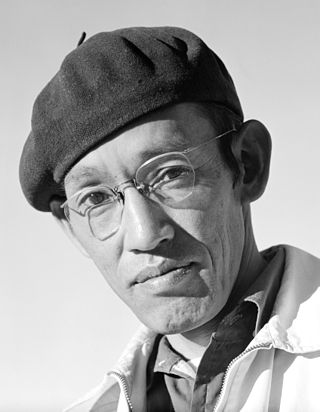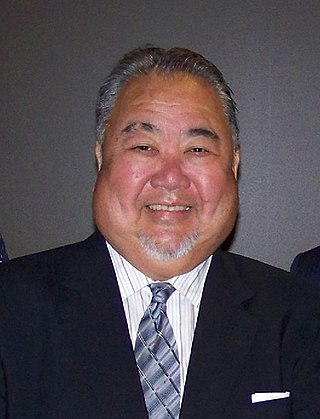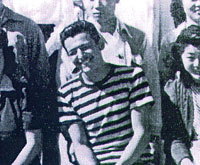Related Research Articles

Manzanar is the site of one of ten American concentration camps, where more than 120,000 Japanese Americans were incarcerated during World War II from March 1942 to November 1945. Although it had over 10,000 inmates at its peak, it was one of the smaller internment camps. The largest was the Tule Lake internment camp, located in northern California with a population of over 18,000 inmates. The smallest was Amanche, located southeastern Colorado, with over 7,000 inmates. It is located at the foot of the Sierra Nevada mountains in California's Owens Valley, between the towns of Lone Pine to the south and Independence to the north, approximately 230 miles (370 km) north of Los Angeles. Manzanar means "apple orchard" in Spanish. The Manzanar National Historic Site, which preserves and interprets the legacy of Japanese American incarceration in the United States, was identified by the United States National Park Service as the best-preserved of the ten former camp sites.

Minidoka National Historic Site is a National Historic Site in the western United States. It commemorates the more than 13,000 Japanese Americans who were imprisoned at the Minidoka War Relocation Center during the Second World War. Among the inmates, the notation "峯土香" was sometimes applied.

Tōyō Miyatake was a Japanese American photographer, best known for his photographs documenting the Japanese American people and the Japanese American internment at Manzanar during World War II.

Visual Communications –– is a community-based non-profit media arts organization based in Los Angeles. It was founded in 1970 by independent filmmakers Robert Nakamura, Alan Ohashi, Eddie Wong, and Duane Kubo, who were students of EthnoCommunications, an alternative film school at University of California, Los Angeles. The mission of VC is to "promote intercultural understanding through the creation, presentation, preservation and support of media works by and about Asian Pacific Americans."
Hiroshi Kashiwagi was a Nisei poet, playwright and actor. For his writing and performance work on stage he is considered an early pioneer of Asian American theatre.
On February 19, 1942, shortly after Japan's surprise attack on Pearl Harbor in Hawaii, President Franklin D. Roosevelt signed Executive Order 9066 authorizing the forced removal of over 110,000 Japanese Americans from the West Coast and into internment camps for the duration of the war. The personal rights, liberties, and freedoms of Japanese Americans were suspended by the United States government. In the "relocation centers", internees were housed in tar-papered army-style barracks. Some individuals who protested their treatment were sent to a special camp at Tule Lake, California.

Yuki Shimoda was an American actor best known for his starring role as Ko Wakatsuki in the NBC movie of the week Farewell to Manzanar in 1976. He also co-starred in the 1960s television series Johnny Midnight, with Edmond O'Brien. He was a star of movies, early television, and the stage. His Broadway stage credits include Auntie Mame with Rosalind Russell, and Pacific Overtures, a musical written by Stephen Sondheim and directed by Harold Prince.

Warren T. Furutani is an American politician who served in the California State Assembly from 2008 to 2012. He is a Democrat and a fourth-generation Japanese American. Furutani was elected in a special election in 2008. He replaced Laura Richardson in California's 55th State Assembly district. Prior to being elected, he served on the Los Angeles Unified School District and then the Los Angeles Community College District Board of Trustees. He was the first Asian Pacific American ever elected to the LAUSD in 1987 and became the board's president in 1991.

Renee Tajima-Peña is an American filmmaker whose work focuses on immigrant communities, race, gender and social justice. Her directing and producing credits include the documentaries Who Killed Vincent Chin?, No Más Bebés, My America...or Honk if You Love Buddha, Calavera Highway, Skate Manzanar, Labor Women and the 5-part docuseries Asian Americans.
Togo W. Tanaka was an American newspaper journalist and editor who reported on the difficult conditions in the Manzanar camp, where he was one of 110,000 Japanese Americans who had been relocated after the Japanese attack on Pearl Harbor on December 7, 1941.
William Minoru Hohri was an American political activist and the lead plaintiff in the National Council for Japanese American Redress lawsuit seeking monetary reparations for the internment of Japanese Americans during World War II. He was sent to the Manzanar concentration camp with his family after the attack on Pearl Harbor triggered the United States' entry into the war. After leading the NCJAR's class action suit against the federal government, which was dismissed, Hohri's advocacy helped convince Congress to pass legislation that provided compensation to each surviving internee. The legislation, signed by President Ronald Reagan in 1988, included an apology to those sent to the camps.
The Seattle Asian American Film Festival was founded in 1985 and has been revived over the years by different producers. The current iteration was founded in 2012 and made its debut in 2013 by co-founders Kevin Bang and Vanessa Au. It is a revival of of the previously running Northwest Asian American Film Festival, which was directed by Wes Kim from 2003 to 2007 and which had experienced a five-year hiatus. The inaugural film festival was also held at the Wing Luke Asian Museum from January 25 to 27, 2013. The festival is currently run and directed by Executive Director, Vanessa Au, and Festival Director, Victoria Ju.

Joyce Nakamura Okazaki is an American citizen of Japanese heritage who was forcibly removed with her family from their Los Angeles home and placed in the Manzanar War Relocation camp in 1942. She was photographed by Ansel Adams in both 1943 and 1944 for his book, Born Free and Equal: The Story of Loyal Japanese Americans. In the 2001 reprint of the book, Okazaki's photograph appeared on the book jacket cover. She was the treasurer of the Manzanar Committee, from July 2010 to February 2021, an NGO which promotes education about the World War II incarceration of Japanese-Americans.
Tadashi "Tad" Nakamura is an American documentary filmmaker. He is noted for films about the Asian-American and Japanese-American communities in the United States.

Ralph Lazo was the only known non-spouse, non-Japanese American who voluntarily relocated to a World War II Japanese American internment camp. His experience was the subject of the 2004 narrative short film Stand Up for Justice: The Ralph Lazo Story.
Mary Kageyama Nomura is an American singer of Japanese descent who was relocated and incarcerated for her ancestry at the Manzanar concentration camp during World War II and became known as The songbird of Manzanar.
Karen L. Ishizuka is an independent writer, curator, and documentary producer. She is a third-generation Japanese American and her family was incarcerated during World War II.

Takayo "Rose" Matsui Ochi was a Japanese-American attorney and civil rights activist notable for fighting for the approval of the Manzanar to become a National Historic Site and being the first Asian American woman to be appointed at the United States Assistant Attorney General level by President Bill Clinton, as well as being the first Asian American to be appointed to the Los Angeles Police Commission.
References
- ↑ "Densho interview segment 3: Robert A. Nakamura". 2011-11-30. Retrieved 2021-06-15.
- ↑ Unger, Leslie (January 11, 2016). "JANM Announces Honorees and Theme for 2016 Annual Gala Dinner". Japanese American National Museum.
- ↑ "Tribute Reel to Robert Nakamura: Godfather of Asian American Media". Center for Asian American Media. May 24, 2012.
- ↑ "UCLA Center for EthnoCommunications". Asian American Studies Center, UCLA. Retrieved 2020-09-23.
- ↑ "Faculty Advisory Committee (FAC): 2018-19". Asian American Studies Center, UCLA. Retrieved 2020-09-23.
- ↑ "Preserved Projects". Academy of Motion Picture Arts & Sciences . Retrieved 2020-09-24.